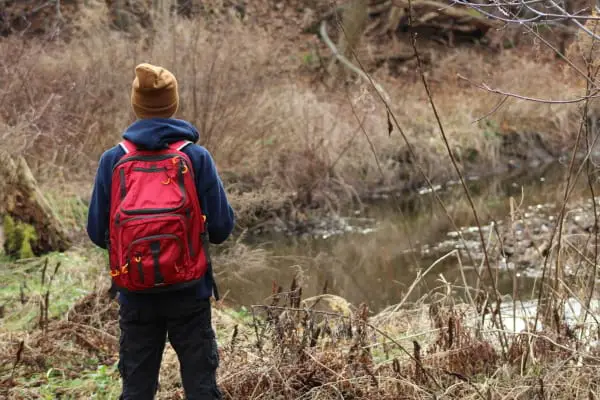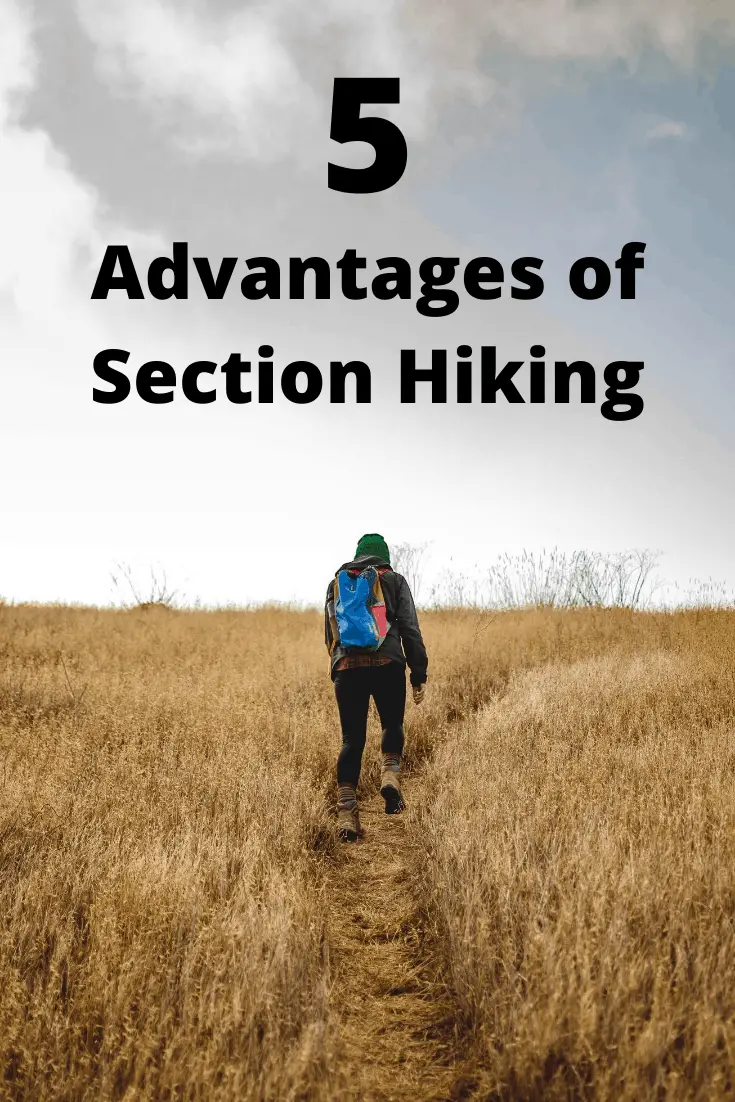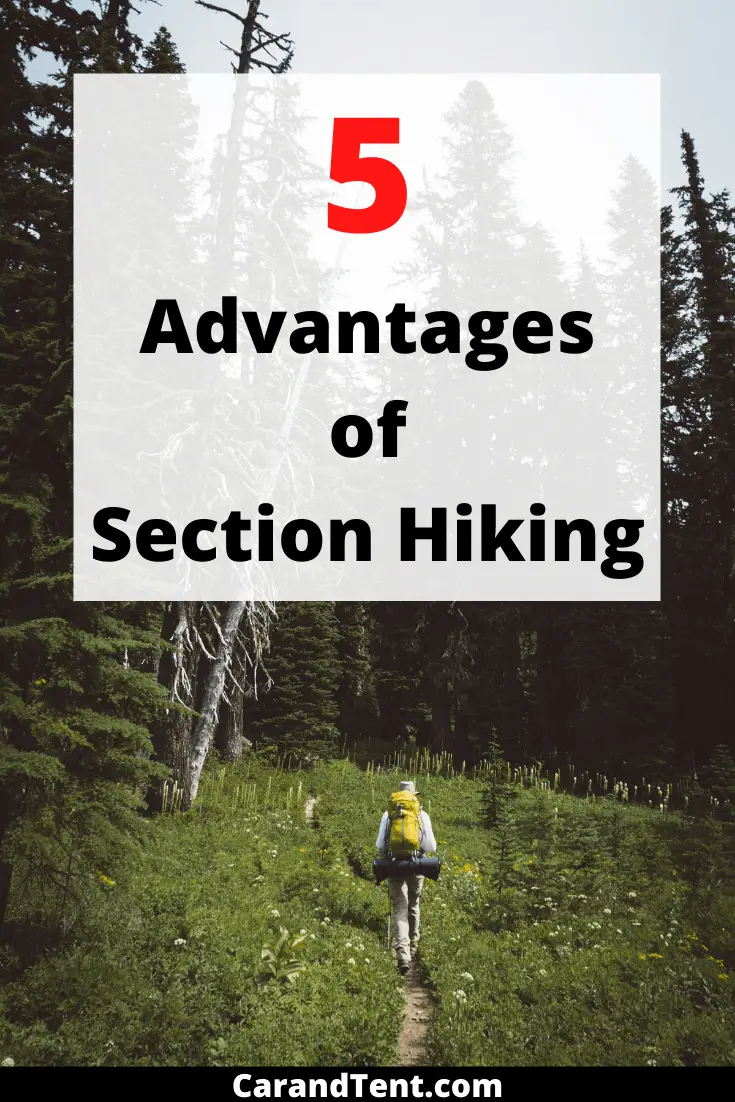
Ever considered the thru hiking vs backpacking debate? If you’re new to hiking, you might be wondering what the difference between thru-hiking and backpacking is.
Thru-hiking is the act of backpacking the entire length of a trail from start to finish. This often makes thru-hiking and backpacking the same thing.
However, while all thru-hikers are considered backpackers, not all backpackers are considered thru-hikers. A backpacker might decide not to complete an entire trail at once or even at all.
Instead, they’ll do what’s known as section hiking.
Section hiking is simply the act of backpacking through part of a trail without finishing it all in one go.
As you can see, a thru-hiker is a backpacker and a section hiker is a backpacker but a backpacker won’t be both of those at the same time.
In the rest of this post, we’ll compare thru-hikers and section hikers so you can see what type of backpacking might be best for you.
Table of Contents
5 Advantages of Thru-Hiking
Thru-hiking long trails can be mentally, physically, and emotionally challenging. On top of this, hikers have to make many sacrifices to accomplish thru-hikes.
So why do they do it?
Here are the top 5 advantages of thru-hiking.
1. It’s Less Expensive
One of the top expenses backpackers face is the expense of getting to their destination. For instance, a person living in Delaware will have to travel all the way down to Georgia or all the way up to Maine to start the Appalachian Trail.
If they decide to backpack the Pacific Crest Trail instead, they’ll have to fly all the way out to the west coast. A thru-hiker will only have to pay for travel costs to the trail and back. These costs aren’t so bad when you only have to do them once.
On the other hand, this cost can get incredibly expensive when it has to be done over and over again. A section hiker does have to do it over and over again.
In fact, some section hikers might attempt to hike a 6-month trail in two-week increments. This adds up to at least 12 different trips and can easily cost them five figures.
2. You Only Have to Earn Your Trail Legs Once
If you’ve ever logged a bunch of backpacking miles in one day, you’ve probably experienced the blisters, the swollen feet, the random aches, and the kind of fatigue that comes with pushing yourself past exhaustion.
Keep doing this day after day and your feet will eventually become calloused, your leg muscles will become strong, and the random joints, tendons, and muscles that used to bother you will become a thing of the past.

A thru-hiker only has to “break themselves in” once per trail. Section-hikers don’t have this advantage. Instead, they might never stay on the trail long enough to harden their bodies and their minds and as a result, they’ll physically and mentally have a less pleasant experience out on the trail.
Not only this, but they won’t be able to hike the trail as fast either. Because section hikers have to start over each year, they usually end up having to hike fewer miles each day.
3. You’re More Likely to Finish
A thru-hiker only has a relatively short period of time where life can get in the way of them finishing a trail. Section-hikers have many chances for life to change and for their chances of completing a trail to go down.
For example, a backpacker looking to take ten years to finish a trail might end up deciding to quit because the yearly trips are using up the only vacation time they have with their new family.
Another person might end up finding themselves in a new line of work that doesn’t give them vacations that are long enough to backpack in. Still, another person might become injured, contract a disease, or just fall out of love with backpacking.
A lot more can happen over a period of ten years when compared to a period of 6 months. If you doubt this, take a moment to compare your life from ten years ago to your life now.
4. You’re More Likely to Make Trail Friends
Section-hikers are on the trails and back off of them in relatively short order. This doesn’t leave a whole lot of time for making friends and bonding with other backpackers.
Thru-hikers don’t have this problem and they often do make a lot of like-minded friends while out on the trail. This is great as it introduces them to other people that they can complete other hikes with. It also makes the trip less lonely, which can be disheartening for extreme extroverts attempting to spend a lot of time out on the trail.
5. It’s Offers a Better Sense of Accomplishment
Watch any documentary on thru-hiking and you’ll quickly see how emotional it can be for a thru-hiker to finish their journey. You’ll see leaps of excitement, tears of sadness and joy, and a whole host of other emotions wash over them.
They’ve just accomplished something big and they know it.
Section-hikers really don’t get to experience this in the same way. Sure, they’ve hiked the same number of miles and maybe even more, but they’ve done it over such a long time that it was more of a fun hobby rather than an experience.
They just didn’t have the same mental and emotional battles and the low points that most thru-hikers had on their trip and as a result, they don’t get the same mental and emotional high at the end either.
5 Advantages of Section Hiking
While thru-hikers might get all the glory, they do miss out on some key benefits that section hikers get to enjoy.
Here are the 5 advantages of section-hiking instead of thru-hiking.
1. You’re Less Likely to Get Hurt
I’ve read that 40% of thru-hikers end up becoming injured while out on the trail. This is probably why 2/3rds of the people who attempt to thru-hike the AT end up having to quit before finishing.
Unfortunately, many of these people wouldn’t have gotten injured if they weren’t pushing themselves past their limits. Remember, thru-hikers only have so much time to complete their hike so there are only so many “zero days” that they can take without falling too far behind.
For example, if you can’t get to Mt Katahdin before it closes for the season, you could end up hiking almost the entire trail without finishing it.
A section-hiker doesn’t have restrictions like this. If a section hiker feels like they’re starting to develop an injury, they can always quit and come back later.
2. You Don’t Have to Quit Your Job
Not many people have the luxury of taking off work for 3 – 6 months at a time. This forces backpackers to save up money so that they can quit or at least take a long leave of absence from their job.
Even contractors who have the option to work or to not work still have to save up money for these time periods. After all, your bills aren’t going to suddenly stop just because you woke up one day and decided the trails were calling.

A section-hiker doesn’t really have this problem. Section-hikers can tackle every mile of the trail on their own terms and when it’s convenient for them.
Depending on how far a person lives from the trail, they can start off by doing it one weekend at a time. This is especially advantageous to people who are just starting out in their careers and who don’t have a lot of time off just yet. As they progress and earn more time off, they can spend more time on the trail without ever hurting themselves financially.
3. You’re Friends Are More Likely to Join You
You’re friends probably have jobs, families, and other responsibilities too. Most of them aren’t going to be able to drop everything and go on a long thru-hike with you.
This being said, your friends probably will have a weekend or a week or two each year that they can devote to backpacking with you. As a result, you won’t have to worry about making trail friends because you’ll already have your own friends with you.
4. You Get to Pick When and Where to Hike each Year
Thru-hikers often hike through rainy springs, sweltering hot summers, and chilly falls. They have to do this because they wouldn’t be able to complete the trip in one go without doing so.
Section-hikers get to choose the seasons they hike in. For instance, a section hiker can hike through the south in the fall when it’s cool and then turn around next year and visit the northern states in late or early summer when it’s still warm.
5. You Get to Go Slower
Backpackers get to explore parts of the country that other people only dream about. They get to pass through wilderness areas and get close to wildlife that they’d never encounter otherwise.
Unfortunately, when they’re on a deadline and they’re pushing themselves to do more and more miles each day, they don’t get to fully enjoy these benefits.
Many section hikers realize this and they do fewer miles each day and take more zero days each week so that they can stop to take pictures and to simply enjoy their surroundings.
Final Thoughts
Thru-hiking and section hiking are both fantastic ways to backpack. They both have their pros and cons and fortunately for all of us, we can choose the one that best meets our individual needs.



